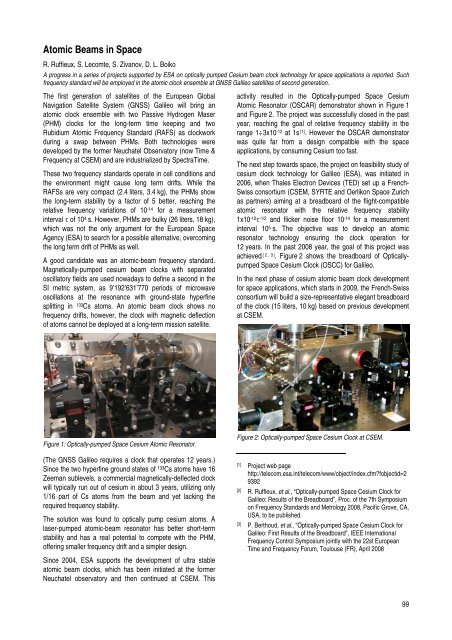CSEM Scientific and Technical Report 2008
CSEM Scientific and Technical Report 2008
CSEM Scientific and Technical Report 2008
Create successful ePaper yourself
Turn your PDF publications into a flip-book with our unique Google optimized e-Paper software.
Atomic Beams in Space<br />
R. Ruffieux, S. Lecomte, S. Zivanov, D. L. Boiko<br />
A progress in a series of projects supported by ESA on optically pumped Cesium beam clock technology for space applications is reported. Such<br />
frequency st<strong>and</strong>ard will be employed in the atomic clock ensemble at GNSS Galileo satellites of second generation.<br />
The first generation of satellites of the European Global<br />
Navigation Satellite System (GNSS) Galileo will bring an<br />
atomic clock ensemble with two Passive Hydrogen Maser<br />
(PHM) clocks for the long-term time keeping <strong>and</strong> two<br />
Rubidium Atomic Frequency St<strong>and</strong>ard (RAFS) as clockwork<br />
during a swap between PHMs. Both technologies were<br />
developed by the former Neuchatel Observatory (now Time &<br />
Frequency at <strong>CSEM</strong>) <strong>and</strong> are industrialized by SpectraTime.<br />
These two frequency st<strong>and</strong>ards operate in cell conditions <strong>and</strong><br />
the environment might cause long term drifts. While the<br />
RAFSs are very compact (2.4 liters, 3.4 kg), the PHMs show<br />
the long-term stability by a factor of 5 better, reaching the<br />
relative frequency variations of 10-14 for a measurement<br />
interval τ of 104 s. However, PHMs are bulky (26 liters, 18 kg),<br />
which was not the only argument for the European Space<br />
Agency (ESA) to search for a possible alternative, overcoming<br />
the long term drift of PHMs as well.<br />
A good c<strong>and</strong>idate was an atomic-beam frequency st<strong>and</strong>ard.<br />
Magnetically-pumped cesium beam clocks with separated<br />
oscillatory fields are used nowadays to define a second in the<br />
SI metric system, as 9’192’631’770 periods of microwave<br />
oscillations at the resonance with ground-state hyperfine<br />
splitting in 133Cs atoms. An atomic beam clock shows no<br />
frequency drifts, however, the clock with magnetic deflection<br />
of atoms cannot be deployed at a long-term mission satellite.<br />
Figure 1: Optically-pumped Space Cesium Atomic Resonator.<br />
(The GNSS Galileo requires a clock that operates 12 years.)<br />
Since the two hyperfine ground states of 133Cs atoms have 16<br />
Zeeman sublevels, a commercial magnetically-deflected clock<br />
will typically run out of cesium in about 3 years, utilizing only<br />
1/16 part of Cs atoms from the beam <strong>and</strong> yet lacking the<br />
required frequency stability.<br />
The solution was found to optically pump cesium atoms. A<br />
laser-pumped atomic-beam resonator has better short-term<br />
stability <strong>and</strong> has a real potential to compete with the PHM,<br />
offering smaller frequency drift <strong>and</strong> a simpler design.<br />
Since 2004, ESA supports the development of ultra stable<br />
atomic beam clocks, which has been initiated at the former<br />
Neuchatel observatory <strong>and</strong> then continued at <strong>CSEM</strong>. This<br />
activity resulted in the Optically-pumped Space Cesium<br />
Atomic Resonator (OSCAR) demonstrator shown in Figure 1<br />
<strong>and</strong> Figure 2. The project was successfully closed in the past<br />
year, reaching the goal of relative frequency stability in the<br />
range 1÷3x10-12 at 1s [1] . However the OSCAR demonstrator<br />
was quite far from a design compatible with the space<br />
applications, by consuming Cesium too fast.<br />
The next step towards space, the project on feasibility study of<br />
cesium clock technology for Galileo (ESA), was initiated in<br />
2006, when Thales Electron Devices (TED) set up a French-<br />
Swiss consortium (<strong>CSEM</strong>, SYRTE <strong>and</strong> Oerlikon Space Zurich<br />
as partners) aiming at a breadboard of the flight-compatible<br />
atomic resonator with the relative frequency stability<br />
1x10-12τ-1/2 <strong>and</strong> flicker noise floor 10-14 for a measurement<br />
interval 105 s. The objective was to develop an atomic<br />
resonator technology ensuring the clock operation for<br />
12 years. In the past <strong>2008</strong> year, the goal of this project was<br />
achieved [ 2, 3] . Figure 2 shows the breadboard of Opticallypumped<br />
Space Cesium Clock (OSCC) for Galileo.<br />
In the next phase of cesium atomic beam clock development<br />
for space applications, which starts in 2009, the French-Swiss<br />
consortium will build a size-representative elegant breadboard<br />
of the clock (15 liters, 10 kg) based on previous development<br />
at <strong>CSEM</strong>.<br />
Figure 2: Optically-pumped Space Cesium Clock at <strong>CSEM</strong>.<br />
[1] Project web page<br />
http://telecom.esa.int/telecom/www/object/index.cfm?fobjectid=2<br />
9392<br />
[2] R. Ruffieux, et al., “Optically-pumped Space Cesium Clock for<br />
Galileo: Results of the Breadboard”, Proc. of the 7th Symposium<br />
on Frequency St<strong>and</strong>ards <strong>and</strong> Metrology <strong>2008</strong>, Pacific Grove, CA,<br />
USA, to be published.<br />
[3] P. Berthoud, et al., “Optically-pumped Space Cesium Clock for<br />
Galileo: First Results of the Breadboard”, IEEE International<br />
Frequency Control Symposium jointly with the 22st European<br />
Time <strong>and</strong> Frequency Forum, Toulouse (FR), April <strong>2008</strong><br />
99








